Shocker & Terror: Kamen Rider’s Darkest Themes
Thematically, Kamen Rider started off as a darker science fiction series with a moralistic core. As time went on, we eventually saw series released under the Kamen Rider name with a more lighthearted approach. However, the grimier roots of Kamen Rider seem to remain fan favorites!
Here’s an overview of some of Kamen Rider‘s past and present grittier elements. Note: There are some important plot points revealed for each show mentioned, so be careful of spoilers!
Part 1: Showa Era’s Dark Themes
Kamen Rider/Kamen Rider 2 (1971 – 1973)
In the beginning, Kamen Riders did not have the luxury of finding or receiving a Belt/Driver imbued with the powers to transform- they were altered human beings. Put plainly, they were cyborgs. This half man/half machine theme was a very popular trope at the time, and Kamen Rider was no exception.
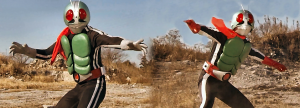
Humans were being captured and altered by the terrorist organization, Shocker. They intended to use these modified agents in their grand scheme of world domination. However, Takeshi Hongo – the original Kamen Rider – narrowly escaped and managed to fight off his captors with his new abilities.
Takeshi soon dedicated his time to fighting Shocker and ruining their plans, which is how he eventually met and rescued Ichimonji Hayato – Kamen Rider 2. Ichimonji was saved by Kamen Rider just before being brainwashed, meaning he too had been altered with superhuman strength, but still retained his conscience.
All large units of baddies may appear as ‘terrorists,’ but Shocker was implicitly a terrorist organization. In addition, they had several lieutenants that were clearly based on well-known dictators from history.
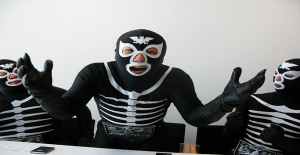
I always thought that there was something more unsettling about a genuine terrorist group made up of your fellow man aiming to capture and brainwash the world than monsters with zippers on their backs that you know don’t actually exist.
Kamen Rider V3 (1973 – 1974) In Kamen Rider V3, Japan is plagued by a similar terrorist organization threat – now under the name of Destron. However, that alone isn’t what gives this series its dark start.
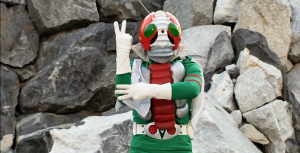
Kazami Shiro, better known as Kamen Rider V3, is thrust into a wave of bad events after witnessing the murder of a civilian at the hands of Destron. Being the only living witness of the killing, several attempts are made to take his life, each one worse than the last.
If matters didn’t already seem bleak for Kazami, they certainly would on one night in particular, when he witnessed his entire family being murdered before him. He was then also gravely wounded by Turtle Bazooka, one of Destron’s minions.
After this, he volunteered to undergo the same procedure as Kamen Rider 1 and 2 in order to seek revenge for his family, thus becoming Kamen Rider V3, in order to seek revenge for his family. Both Kamen Riders 1 and 2 performed the surgery, giving him the same skills they had, along with new skills he would discover and perfect throughout the course of the series.
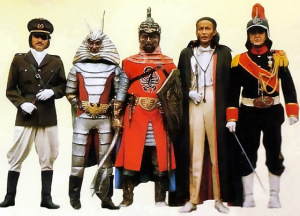
He soon followed in his mentors’ footsteps to defeat Destron, but Destron didn’t stop at his family- they took even more from him. While Kazami was busy fending off one Destron beast, Kamen Riders 1 and 2 were off fighting another Destron enemy – the same Turtle Bazooka who wounded Kazami and forced him to become V3.
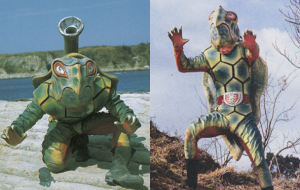
Turtle Bazooka’s initial goal was to be a suicide bomber and kill both himself and the citizens in Shinjuku. Already a dark demise in itself, Kamen Riders 1 and 2 then sacrificed themselves in order to save the lives of many others by flying away from the city carrying the armed and live Turtle Bazooka, thus exploding along with the minion over the sea.
And this was only two episodes into the series.
Kazami Shiro lost his normal way of life, his entire family, and the closest things he had to mentors in record time. Kamen Rider V3 remains one of my favorite examples of how dark Kamen Rider series can be.
Kamen Rider BLACK (1987 – 1988)
When terrorist organizations became old hat, Toei brought in a new trope – cults.
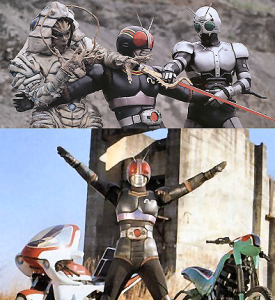
Kamen Rider BLACK faced many foes, including the infamous Shadow Moon.
It’s the 1980’s. Life is good, large suit jackets and tight pants are in, and everyone is having a great time. Step-brothers Kotaro and Nobuhiko are celebrating their 19th birthday in style, but the party’s attendance is a bit questionable. They soon realize that there are members of a cult named Gorgom among them, and they are there for more than cake and punch – they are there for fresh 19-year-old blood!
The two brothers, born during a solar eclipse, are given to Gorgom as martyrs to be transformed into cyborgs. The expectation was to pit them against one another in battle with the winner becoming the Creation King, their deity.
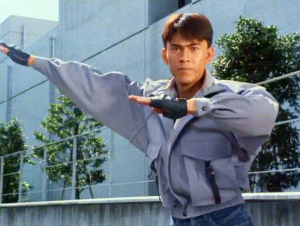
Eventually, it is revealed that their father, an archaeologist, had agreed to hand over his sons to Gorgom in exchange for financially backing his projects in archaeology. During the final phase of the cyborg surgery, he had a sudden change of heart and defied Gorgom’s orders. Kotaro, his adopted son, was able to interrupt the last and integral brainwashing phase that removes all morality. He then escapes from Gorgom’s clutches, and his father loses his life for assisting him in doing so.
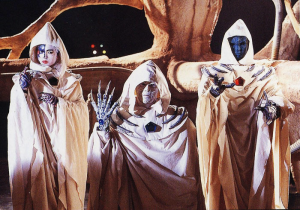
Kotaro assumes his place as Kamen Rider BLACK, but still has to live with the betrayal of his step-father, learning the truth about his real parents, and losing a brother to a demonic cult.
Even early on, Kamen Rider showed themes that are considered touchy by today’s standards. The basic special effects and sometimes laughable fight scenes may take away from that, but when the plots and goals for these villains are looked at for what they are, the series appear much darker.
What are some other plot elements from Showa-era Rider series that were shockingly dark to you?
